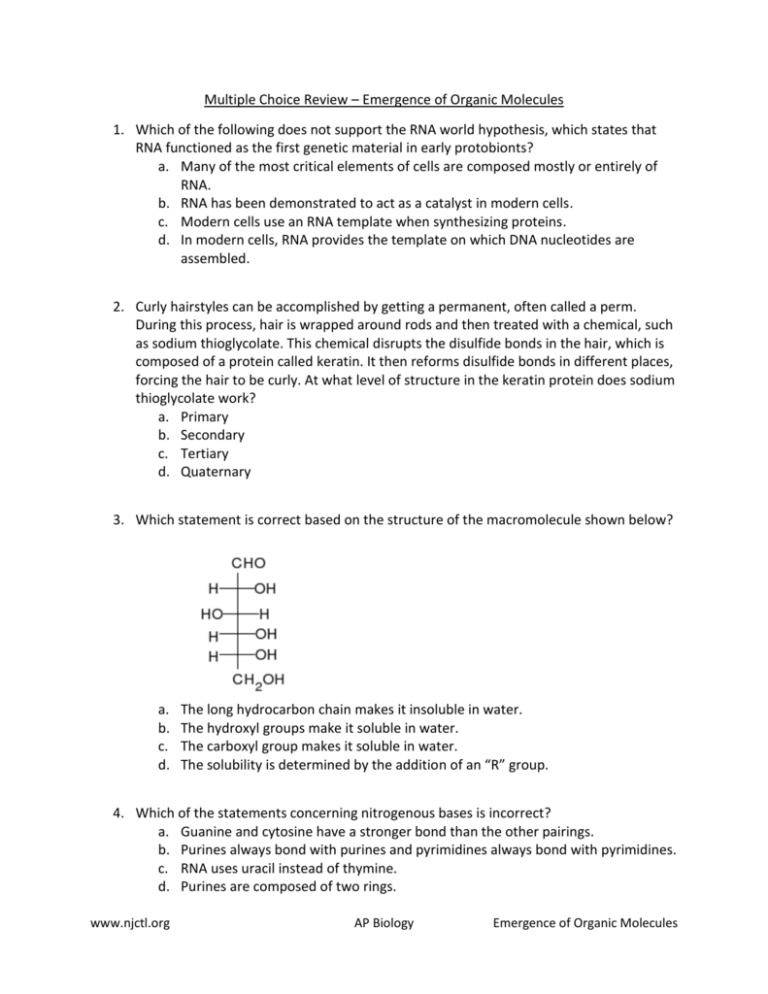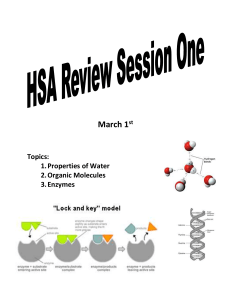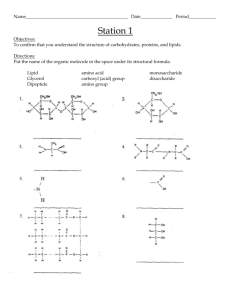Multiple Choice Review – Emergence of Organic Molecules Which
advertisement

Multiple Choice Review – Emergence of Organic Molecules 1. Which of the following does not support the RNA world hypothesis, which states that RNA functioned as the first genetic material in early protobionts? a. Many of the most critical elements of cells are composed mostly or entirely of RNA. b. RNA has been demonstrated to act as a catalyst in modern cells. c. Modern cells use an RNA template when synthesizing proteins. d. In modern cells, RNA provides the template on which DNA nucleotides are assembled. 2. Curly hairstyles can be accomplished by getting a permanent, often called a perm. During this process, hair is wrapped around rods and then treated with a chemical, such as sodium thioglycolate. This chemical disrupts the disulfide bonds in the hair, which is composed of a protein called keratin. It then reforms disulfide bonds in different places, forcing the hair to be curly. At what level of structure in the keratin protein does sodium thioglycolate work? a. Primary b. Secondary c. Tertiary d. Quaternary 3. Which statement is correct based on the structure of the macromolecule shown below? a. b. c. d. The long hydrocarbon chain makes it insoluble in water. The hydroxyl groups make it soluble in water. The carboxyl group makes it soluble in water. The solubility is determined by the addition of an “R” group. 4. Which of the statements concerning nitrogenous bases is incorrect? a. Guanine and cytosine have a stronger bond than the other pairings. b. Purines always bond with purines and pyrimidines always bond with pyrimidines. c. RNA uses uracil instead of thymine. d. Purines are composed of two rings. www.njctl.org AP Biology Emergence of Organic Molecules 5. Many plant leaves have an outer layer, called the waxy cuticle, that aids in the prevention of dehydration via transpiration. When water falls on the waxy cuticle, it immediately beads up and rolls off. Based on this information, what must be true of the waxy cuticle? a. It is amphiphilic. b. It hydrolyzes the water molecules. c. It is hydrophobic. d. It has catalytic properties. 6. The theory that organic compounds arose from the inorganic molecules present on early Earth relies on all of the following assumptions except for one. Which one is an incorrect assumption? a. High energy input in the form of lighting and/or UV radiation b. Oxygen gas present in the atmosphere c. The presence of inorganic molecules d. The Earth is 4.6 billion years old, allowing sufficient time for evolution to occur. 7. When glycogen is hydrolyzed, it forms a. Cellulose b. Sucrose c. Polysaccharides d. Glucose 8. DNA and RNA are composed of several nucleotide monomers bonded together. Where does this bond occur between two nucleotides? a. Between the sugar and the phosphate b. Between adjacent nitrogenous bases c. Between the sugar and the neighboring nitrogenous base d. Between the phosphate and the neighboring nitrogenous base 9. Scientific experiments strive to be both accurate and reliable. Which of the following techniques does not do so? a. Increasing the sample size b. Being precise in all procedures and measurements c. Decreasing control variables d. Repeating the experiment several times www.njctl.org AP Biology Emergence of Organic Molecules 10. Soap is used to wash soluble and insoluble substances off of surfaces. While the water used with soap is able to dissolve soluble substances, it has no effect on insoluble substances. A hydrophobic molecule in soap is able to dissolve insoluble substances. Which of the following could be a molecule used in soap? a. Polysaccharide b. Fatty acid c. Chitin d. Pyrimidine 11. Galactose and glucose are both monosaccharides with the molecular formula C6H12O6. When these two molecules undergo dehydration synthesis, they form lactose, milk sugar. What is the structural formula of lactose? a. C11H22O12 b. C12H24O12 c. C12H23O11 d. C12H22O11 12. Which statement is correct based on the structure of the macromolecule shown below? O O P O- O CH2 O CH H H H H O–C–C–C–C–C–H H H H H H H H H CH2 a. b. c. d. www.njctl.org O–C–C–C–C–C–H O H H H H The molecule is amphiphilic. The molecule contributes to high cholesterol. The molecule is used for energy storage. The molecule can fold in on itself because of its polar “R” group. AP Biology Emergence of Organic Molecules 13. Some scientists believe that the first monomers on early Earth came from meteorites that fell to Earth. What evidence do scientists use to support this theory? a. An experiment conducted by Stanley-Miller simulated meteorite conditions and were able to produce important monomers. b. Pieces of meteorites that have been found to contain a variety of organic chemicals. c. The astronomer Edward Hubble observed this happening on other planets. d. Meteorites are amphiphilic and therefore are capable of carrying foreign molecules through Earth’s atmosphere. 14. When a strand of DNA is unfolded, the bases on one side read as follows: 5’ – TCAG – 3’ What will the complimentary strand read? a. 5’ – AGUC – 3’ b. 5’ – AGTC – 3’ c. 3’ – AGUC – 5’ d. 3’ – AGTC – 5’ 15. Which of the following levels of protein structure is not interrupted during denaturation? a. Primary b. Secondary c. Tertiary d. Quaternary 16. A scientist is working with a polysaccharide that consists of 15 monosaccharides. How many molecules of water will be required to completely hydrolyze the molecule? a. 13 b. 14 c. 15 d. 16 17. The first cells are thought to have been an accumulation of organic molecules. Called protobionts, these first cells contained all of the following capabilities, except a. Metabolism b. Separation from the outer environment c. Replication d. Photosynthesis www.njctl.org AP Biology Emergence of Organic Molecules 18. A nucleoside is composed of a ribose or deoxyribose sugar linked to a nitrogenous base. What else is required in order for the nucleoside to become a nucleotide? a. One of 20 R groups. b. Either a purine or a pyrimidine c. A phosphate group d. Glycerol 19. Most biomolecules are polymers composed of monomer building blocks. Which category of biomolecules does not follow this plan? a. Lipids b. Carbohydrates c. Proteins d. Nucleic Acids 20. Which statement is correct based on the structure of the molecule shown below? H H H H H H H O C – C – C – C – C – C – C – C -- H O H H H H H H H H a. b. c. d. The molecule can be found in seeds. The molecule contributes to high LDL cholesterol. The molecule is solid at room temperature. The molecule is stored as glycogen in the body. 21. Which of the following statements about protein structure is incorrect? a. A change in one amino acid in the primary structure will cause a change in the entire protein. b. Secondary structure uses hydrophobic interactions and to create folds in the polypeptide backbone. c. Tertiary structure is the result of interactions between the side chains. d. Quaternary structure folds several polypeptides into a functional protein. 22. Which of the following is not true concerning the differences between RNA and DNA? a. RNA contains pyrimidines while DNA contains purines. b. The sugar in DNA contains one less oxygen than the sugar in RNA. c. DNA forms a double helix while RNA is able to fold in on itself. d. RNA is thought to have evolved before DNA. www.njctl.org AP Biology Emergence of Organic Molecules 23. There are several similarities that are found among all living organisms. For example, organisms use ATP as the source of energy. A universal genetic code is found in all organisms. Sodium and potassium ion pumps are used as the method to create potential. What theory do these pieces of evidence support? a. Protobionts b. Endosymbiosis c. RNA world d. LUCA 24. Which of the following is an inaccurate statement about denaturation. a. Denaturation can be reversible. b. Denaturation affects primary, secondary, and tertiary structure but not quaternary structure. c. Denaturation can occur as a result of inadequate pH levels. d. Denaturation disrupts all hydrogen bonding. 25. Which statement is correct based on the structure of the molecule shown below? R N O H–C–C N OH H a. The monomer is always polar. b. When several of these are linked together, they represent the first out of four levels of structure. c. The unique order of nitrogenous bases gives the macromolecule its function. d. The monomers of this type of macromolecule are connected via phosphodiester bonds. 26. Chitin is a polysaccharide similar to cellulose, except that one hydroxyl group is replaced with a nitrogen group. In its natural state, chitin is strong but pliable. When paired with calcium carbonate, however, it becomes very strong and inflexible. Which of the following statements must also be true concerning chitin? a. It is composed of glucose. b. It is double stranded. c. It can be denatured at high temperatures. d. It is liquid at room temperature. www.njctl.org AP Biology Emergence of Organic Molecules 27. Starch and glycogen are important polysaccharides. In what way are they different? a. Starch is soluble in water while glucose is not. b. Starch is composed of cellulose while glycogen is composed of glucose. c. Glycogen is found in animals while starch is found in plants. d. They both function as a source of energy. 28. Which of the following is not involved in the tertiary structure of a protein? a. Hydrogen bond b. Disulfide bridge c. Peptide bond d. Ionic bond 29. Animals store fat in adipose tissue. Which of the following pairs has the same relationship as fat and adipose tissue? a. Sugar and the liver b. Amino acid and protein c. RNA and DNA d. Glucose and starch 30. Cholesterol and estrogen are different types of steroids. Cholesterol is an important component of animal cell membranes. Estrogen, on the other hand, is the primary female sex hormone. What do these two molecules have in common? a. They are both composed of peptide bonds. b. Their levels in the body are impacted by levels of saturated fats. c. They are isomers of each other. d. They are both composed of four carbon rings fused together. 31. Which statement is correct based on the structure of the macromolecule shown below? H H H H H H H O H H H C–C–C–C–C–C–C–C O C–C–C–H H H H H H H H H H a. b. c. d. www.njctl.org The kinks in the chain make the molecule insoluble in water. The molecule is amphiphilic. The molecule is solid at room temperature. The molecule contributes to high LDL cholesterol. AP Biology Emergence of Organic Molecules 32. In his 1953 experiment, Stanley Miller successfully created which of the following from NH3, CH4, and H2? a. Amino acids b. Simple monosaccharides c. Hydrocarbons d. RNA 33. How many levels of structure does a single polypeptide chain require to perform a function? a. 1 b. 2 c. 3 d. 4 34. Birds are known to migrate long distances throughout the year. The Manx Shearwater, for example, migrates 8,700 miles between the northern breeding grounds and the southern ocean. During migrations, when food is not available, birds use what type of stores in their body to fuel their flight? a. Amino acids b. Phospholipids c. Chitin d. Triglycerides 35. When the monomers of most macromolecules are linked together, a molecule of water is one of the products. Listed below are several names by which this process is known. Which of the following is not a correct name? a. Peptide bond b. Hydrolysis reaction c. Glycosidic linkage d. Dehydration synthesis www.njctl.org AP Biology Emergence of Organic Molecules Questions 36-40 refer to the experiment described below. Cellulase is an enzyme used in fungi and bacteria to catalyze the hydrolysis of cellulose. To measure the effect of pH on the effectiveness of cellulase, three vials of cellulase are treated with different pH solutions: one vial at pH 3, one vial at pH 7, and one vial at pH 11. Cellulose is then introduced into each vial and the amount of cellulose after every 30 seconds is measured. 36. When cellulose is hydrolyzed, what is the result? a. Starch b. Glycogen c. Glucose d. Amylopectin 37. What is the independent variable? a. Amount of cellulase b. pH c. Temperature d. Amount of cellulose 38. What is the dependent variable? a. Amount of cellulase b. pH c. Temperature d. Amount of cellulose 39. In this experiment, what is the control group? a. The vial at pH 7 b. Maintaining a constant temperature c. The initial amount of cellulose in each vial d. Cellulase 40. How could this experiment be redesigned to increase its reliability? a. The amount of cellulose could be measured every 15 seconds. b. The temperature could be measured in addition to cellulose. c. Additional cellulase could be added throughout the experiment. d. Larger sample sizes at each pH could be used. www.njctl.org AP Biology Emergence of Organic Molecules Quantitative Review – Emergence of Organic Molecules 1. A sample of glycogen contains the molecular formula C120H202O101. How many molecules of water will it require to hydrolyze this molecule into its glucose building blocks? 2. Basic peanut butter cookies can be made by using just three ingredients: 1 cup peanut butter, 1 cup sugar, and 1 egg. This recipe makes 24 cookies. Based on the nutritional information below, calculate how many calories, rounded to the nearest calorie, are consumed when you eat two cookies. Biomolecule Fat Carbohydrate Protein Fat (g) Carbohydrates (g) Protein (g) Peanut Butter (1 cup) 128 48 Calories per gram 9 4 4 Sugar (1 cup) 54 Egg (1) 0 192 5 1 0 7 3. There are 20 different possibilities for side chains in amino acids. Glycine is a side chain composed of one hydrogen atom. Alanine is a side chain composed of CH3. Serine is a side chain composed of a hydroxyl group, OH. If an amino acid chain, composed of glycine, alanine, and serine is synthesized via dehydration synthesis, how many oxygen atoms will the molecule contain? 4. While the origins of Earth are predicted to have occurred 4.6 billion years ago, the earliest life forms did not evolve until 3.9 billion years ago. Eukaryotic organisms evolved 2.1 billion years ago, with multicellular organisms evolving 1.5 billion years ago. How many billion years elapsed between the evolution of eukaryotes and the evolution of multicellular organisms? 5. An average person who consumes 2,000 calories per day has a daily recommended intake of no more than 65 grams of fat. For lunch today, you take a trip to McDonald’s and have a double quarter pounder with cheese (43 g fat) and large French fries (25 g fat). Knowing that there are 9 calories in each gram of fat, by how many calories have you exceeded your daily recommended intake of calories from fats? www.njctl.org AP Biology Emergence of Organic Molecules 6. When the phospholipid shown below is hydrolyzed, how many hydrogen atoms will be in each fatty acid? www.njctl.org AP Biology Emergence of Organic Molecules ANSWER KEY 1. 2. 3. 4. 5. 6. 1. D 2. C 3. B 4. B 5. C 6. B 7. D 8. A 9. C 10. B 11. D 12. A 13. B 14. D 15. A 16. B 17. D 18. C 19. A 20. C 21. B 22. A 23. D 24. B 25. B 26. A 27. C 28. C 29. A 30. D 31. D 32. A 33. C 34. D 35. B 36. C 37. B 38. D 39. A 40. D www.njctl.org AP Biology 19 200 calories 5 0.6 27 30 Emergence of Organic Molecules









